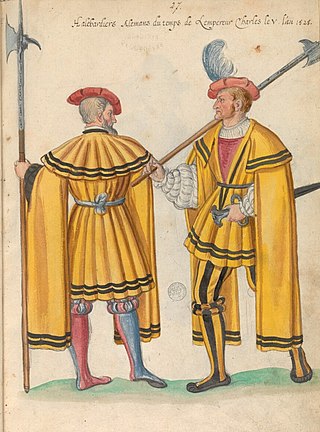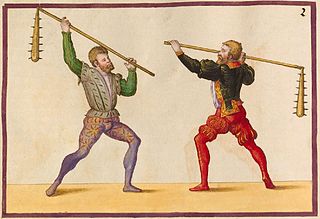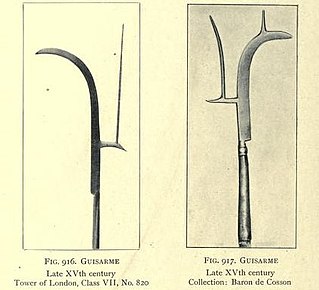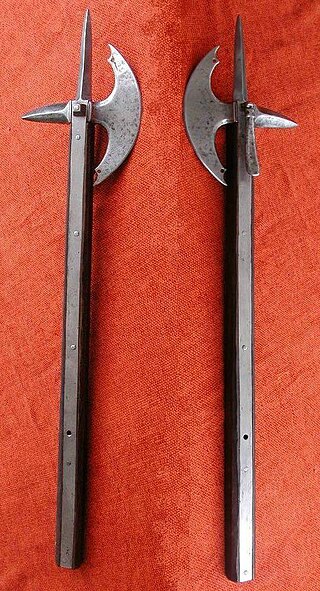
A voulge (also spelled vouge, [1] sometimes called a couteau de breche) is a type of polearm that existed in medieval Europe, primarily in 15th century France. [2]

A voulge (also spelled vouge, [1] sometimes called a couteau de breche) is a type of polearm that existed in medieval Europe, primarily in 15th century France. [2]
A voulge would usually have a narrow single-edged blade mounted with a socket on a shaft. The weapon could additionally feature shaft reinforcements called langets and rondel protection for the hands at the base of the blade. [3] Troops that used the weapon are called voulgiers. [4]
It is a weapon noted to have been used by the Franc-Archers [3] and is also depicted in artwork of their creation. There is a popular erroneous definition of the word voulge in modern times, which refers to a pointy cleaver-like weapon blade attached to the shaft with two hoops like a bardiche. This definition is incorrect and started in the 19th century with Viollet le Duc, and the weapon in question is an early form of halberd. [5]

A polearm or pole weapon is a close combat weapon in which the main fighting part of the weapon is fitted to the end of a long shaft, typically of wood, extending the user's effective range and striking power. Polearms are predominantly melee weapons, with a subclass of spear-like designs fit for thrusting and/or throwing. Because many polearms were adapted from agricultural implements or other fairly abundant tools, and contained relatively little metal, they were cheap to make and readily available. When belligerents in warfare had a poorer class who could not pay for dedicated military weapons, they would often appropriate tools as cheap weapons. The cost of training was comparatively low, since these conscripted farmers had spent most of their lives using these "weapons" in the fields. This made polearms the favoured weapon of peasant levies and peasant rebellions the world over.
A spear is a polearm consisting of a shaft, usually of wood, with a pointed head. The head may be simply the sharpened end of the shaft itself, as is the case with fire hardened spears, or it may be made of a more durable material fastened to the shaft, such as bone, flint, obsidian, copper, bronze, iron, or steel. The most common design for hunting and/or warfare, since ancient times has incorporated a metal spearhead shaped like a triangle, diamond, or leaf. The heads of fishing spears usually feature multiple sharp points, with or without barbs.

A halberd is a two-handed polearm that came to prominent use from the 13th to 16th centuries. The halberd consists of an axe blade topped with a spike mounted on a long shaft. It can have a hook or thorn on the back side of the axe blade for grappling mounted combatants. The halberd was usually 1.5 to 1.8 metres long.

A longsword is a type of European sword characterized as having a cruciform hilt with a grip for primarily two-handed use, a straight double-edged blade of around 80 to 110 cm, and weighing approximately 1 to 1.5 kg.

A pike is a long thrusting spear formerly used in European warfare from the Late Middle Ages and most of the early modern period, and wielded by foot soldiers deployed in pike square formation, until it was largely replaced by bayonet-equipped muskets. The pike was particularly well known as the primary weapon of Swiss mercenary, German Landsknecht units and French sans-culottes. A similar weapon, the sarissa, had been used in antiquity by Alexander the Great's Macedonian phalanx infantry.

A morning star is any of several medieval club-like weapons consisting of a shaft with an attached ball adorned with one or more spikes, each used, to varying degrees, a combination of blunt-force and puncture attack to kill or wound the enemy.

A flail is a weapon consisting of a striking head attached to a handle by a flexible rope, strap, or chain. The chief tactical virtue of the flail was its capacity to strike around a defender's shield or parry. Its chief liability was a lack of precision and the difficulty of using it in close combat, or closely-ranked formations.
The ahlspiess was a thrusting spear developed and used primarily in Germany and Austria from the 15th to 16th centuries. The ahlspiess consisted of a long thin spike of square cross section measuring up to about a metre in length, mounted on a round wooden shaft and sometimes secured with a pair of langets extending from the socket. The length of the shaft ranged from 1.6 to 1.8 m., and located at the base of the spike was a rondel guard to protect the hands. Large numbers of these weapons have survived and are kept in the arsenal and museums of Vienna as well as the Metropolitan Museum of Art.

A glaive, sometimes spelled as glave, is a type of pole weapon with historical origins in Europe, known for its distinctive design and versatile combat applications. It is similar to other polearms such as the war scythe, the Japanese naginata, the Chinese guandao, the Korean woldo, and the Russian sovnya.

The English language terminology used in the classification of swords is imprecise and has varied widely over time. There is no historical dictionary for the universal names, classification, or terminology of swords; a sword was simply a single-edged or double-edged knife.

A guisarme is a polearm used in Europe primarily between 1000 and 1400. Its origin is likely Germanic, from the Old High German getīsarn, literally "weeding iron". Like many medieval polearms, the exact early form of the weapon is hard to define from literary references, and the identification of surviving weapons can be speculative.

A bardiche, berdiche, bardische, bardeche, or berdish is a type of polearm used from the 14th to 17th centuries in Europe. Ultimately a descendant of the medieval sparth axe or Dane axe, the bardiche proper appears around 1400, but there are numerous medieval manuscripts that depict very similar weapons beginning c. 1250. The bardiche differs from the halberd in having neither a hook at the back nor a spear point at the top. The use of bardiches started in early 14th-century Austria.

The Lochaber axe is a type of poleaxe that was used almost exclusively in Scotland. It was usually mounted on a staff about five feet long.

The Dane axe or long axe is a type of European early medieval period two-handed battle axe with a very long shaft, around 0.9–1.2 metres at the low end to 1.5–1.7 metres or more at the long end. Sometimes called a broadaxe, the blade was broad and thin, intended to give a long powerful cut when swung, effective against cavalry, shields and unarmored opponents.

The poleaxe is a European polearm that was used by medieval infantry.

A brandistock was a short type of polearm which was used by both infantry and civilians alike, primarily police officers in Italy between the 16th and 19th centuries. Measuring some 1.5 meters (5 ft) long, the brandistock construction was unique for polearms in that it had a retractable blade. The head consisted of either a single or a trio of long thin points, which were kept in a hollow aperture inside the rest of the shaft. A sharp thrust of the weapon forward propelled the heads out, where they could be readily locked in place. This weapon is essentially a spear with a sliding blade, or alternatively, a long handled out-the-front gravity knife.

A battle axe is an axe specifically designed for combat. Battle axes were specialized versions of utility axes. Many were suitable for use in one hand, while others were larger and were deployed two-handed.
Darts are airborne ranged weapons. They are designed to fly such that a sharp, often weighted point will strike first. They can be distinguished from javelins by the presence of fletching and a shaft that is shorter and/or more flexible. Darts can be propelled by hand or with the aid of a hand-held implement such as a blowgun. They can be distinguished from arrows because they are not used with a bow.

The doloire or wagoner's axe was a tool and weapon used during the Middle Ages and Renaissance. The axe had a wooden shaft measuring approximately 1.5 metres (5 feet) in length and a head that was pointed at the top and rounded at the bottom, resembling either a teardrop or an isosceles triangle. The top of the shaft was fitted with a metal eye or socket that was welded to the head of the axe near the base of the blade. The upper part of the blade extended above the eye, while the opposite side of the socket featured a small blunt hammer head. The head of the axe itself measured approximately 44 cm. (17 inches) in length, was sharpened on the back and flattened bottom edges, and was uniformly decorated with punched and incised abstract floral patterns.

An axe is an implement that has been used for millennia to shape, split, and cut wood, to harvest timber, as a weapon, and as a ceremonial or heraldic symbol. The axe has many forms and specialised uses but generally consists of an axe head with a handle, also called a haft or a helve.
{{cite book}}: CS1 maint: location missing publisher (link){{cite book}}: CS1 maint: location missing publisher (link)